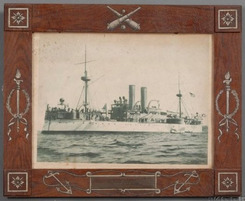 Construction of the U.S.S. Maine was authorized in August of 1886, and she was launched in 1889 and commissioned in 1895. After several years spent patrolling the East Coast and Caribbean, orders sent the Maine and her crew to Cuba in response to continued civil unrest on the island.
Construction of the U.S.S. Maine was authorized in August of 1886, and she was launched in 1889 and commissioned in 1895. After several years spent patrolling the East Coast and Caribbean, orders sent the Maine and her crew to Cuba in response to continued civil unrest on the island.
Three weeks later, on the morning of February 15, 1898, the battleship Maine lay in Havana harbor. Just after the playing of Taps, Captain Charles Sigsbee recalls, “I laid down my pen and listened to the notes of the bugle, which were singularly beautiful in the oppressive stillness of the night. . . . I was enclosing my letter in its envelope when the explosion came. It was a bursting, rending, and crashing roar of immense volume, largely metallic in character. It was followed by heavy, ominous metallic sounds. There was a trembling and lurching motion of the vessel, a list to port. The electric lights went out. Then there was intense blackness and smoke.”
Later investigations determined that the ship’s powder stores detonated, ripping off the forward third of the ship. Such a significant breach caused the ship to sink rapidly, but tragedy occurred almost instantly for the many enlisted men sleeping in the forward section of the Maine. Most of the Maine‘s crew died instantly, with 266 men killed in the explosion and another 8 men dying later from injuries. Officers, who were quartered in the rear of the ship, fared better, with 18 officers among the Maine‘s 89 survivors. Most of the dead were recovered from Havana’s harbor and were buried in Havana, but almost two years later, in December of 1899, the bodies were disinterred and reburied in Arlington National Cemetery.
The explosion brought about the “Remember the Maine!” battle cry and helped precipitate the start of the Spanish-American War in April of 1898, but numerous investigations, both in the period and years later, have attributed the cause to one of two accidental causes. One theory is that a external mine in the harbor detonated, most likely accidentally, while the other generally accepted theory attributes the explosion to spontaneous combustion of the Maine‘s own coal supplies. In either case, the explosion was likely unintentionally and triggered a second, larger explosion by detonating the ship’s powder stores.
Maine-related memorabilia is rare, but appreciated by collectors of historic material when it finds its way to auction. In the aftermath, several companies attempted to capitalize by the patriotic surge the event created, so Maine-related advertising has collectors, but the real money is typically reserved for items related to the Maine in the months before the explosion or pieces created by survivors.



